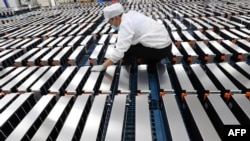The Chinese government announced Friday that it would tighten export controls on graphite, a material essential to the construction of batteries used in electric cars and other green energy systems and of which China is the world’s preeminent supplier.
The Chinese Ministry of Commerce described the new restrictions as "conducive to ensuring the security and stability of the global supply chain and industrial chain, and conducive to better safeguarding national security and interests.”
The move came days after the Biden administration announced that the United States would widen the list of semiconductors that it prevents from being exported to China. The restrictions will now include certain chips made by Nvidia that are widely used in the development of artificial intelligence.
U.S. officials had described the changes to the semiconductor export restrictions as relatively minor ones, meant to close “loopholes” in earlier policy statements.
Careful dance
Experts told VOA that the interaction between the U.S. and China on trade had shifted somewhat in recent months, as the two countries seek a new equilibrium.
As the two largest economies in the world, the U.S. and China have trade ties that are both broad and deep, and despite sometimes acrimonious exchanges between their leaders, the total volume of trade between the two countries is as high today as it has ever been.
Lily McElwee, who holds the Freeman Chair in China Studies at the Center for Strategic and International Studies, said the way that the new measures were rolled out illustrated the changing way in which the U.S. and China communicate about trade policy.
“It is worth noting that both moves were somewhat expected,” McElwee wrote in an email exchange. “In this sense, the U.S. and China have moved into new terrain with this latest set of restrictions. Beijing knew the updated set of rules on the October 2022 AI chip controls was coming, because U.S. officials took steps to socialize the updates with Chinese counterparts.”
McElwee said the existence of joint working groups that evolved after visits to China by Treasury Secretary Janet Yellen and Commerce Secretary Gina Raimondo earlier this year might signal that advance warning about new restrictions may become the norm between Washington and Beijing.
“I see the graphite restrictions as a necessary reaction from Beijing’s perspective, and a carefully designed warning shot, given the use of graphite in EV batteries [relevant for Europe’s green transition, for example],” McElwee wrote. “But it remains to be seen how China will implement them, and I am skeptical they will end up as a major escalation in that regard.”
'Protectionist footsie'
Scott Lincicome, the vice president of general economics at the Cato Institute’s Herbert A. Stiefel Center for Trade Policy Studies, told VOA that despite frequent talk in the U.S. about “decoupling” from China or “de-risking” by reducing reliance on Beijing for certain goods, trade between the two countries is likely to remain robust.
“It's a lot of sound and fury, signifying little,” Lincicome said of the announcements this week.
“Undoubtedly, the United States and China are playing protectionist footsie, in specific technologies: semiconductors, electric vehicles, rare earth minerals and that kind of stuff,” Lincicome said. “But that has to be understood in the broader context of a trade and investment relationship, which quite frankly is still going pretty darn strong.”
Trade policies focused on national security issues will continue to grab headlines, he said, but will remain a small fraction of total trade.
“There's going to be this one group of products that gets all the attention, both in terms of policy and rhetoric,” Lincicome said. “But there's going to be a whole host of stuff that is just private individuals and companies, and in China, some state-owned companies, doing commerce, quietly and hopefully without much attention.”
Chips and batteries
The Biden administration has signaled seriousness about its desire to prevent China from purchasing some of the most advanced semiconductors and semiconductor-manufacturing equipment on the market.
Because both are made with processes subject to U.S. export restrictions, the U.S. can require even third-country manufacturers that make them — using licensed intellectual property — to refuse to export them to China.
The rules issued this week were designed to close loopholes that allowed certain kinds of restricted chips to get through the blockade. In June, for example, the news organization Reuters reported that chips specifically barred from export to China remained available on the open market in the Chinese city of Shenzen.
For its part, China has been flexing its economic muscle by leveraging its dominance in the extraction and processing of rare earth metals and other raw materials necessary for the manufacture of modern electronics and rechargeable batteries.
Graphite, a form of carbon, is used in an array of manufacturing processes and comes in many forms. Under its new rules, China will require special export permits for some forms of graphite, primarily those used in the creation of batteries.
One notable difference in the most recent exchange of trade restrictions is that while the U.S. is explicitly targeting China with its semiconductor export ban, China’s graphite restrictions — like similar recent restrictions it placed on the export of metals gallium and germanium — apply regardless of the country purchasing them.












